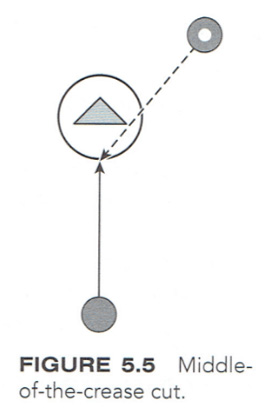|
By: Don Zimmerman and Peter England Originally Published in: Men's Lacrosse Provided by: Human Kinetics Cutting strategy revolves around three key issues: timing, field position, and techniques for cutting near the crease. Cutting requires proper timing because it involves coordinating your actions with a feeder. An off-ball cut can come from any position on the field, and some areas are more dangerous than others. Lastly, cuts near the crease have a special character. You can cut to the tangent of the crease, cut backdoor, or cut to the middle of the crease. Timing Cutting and feeding are all about timing. When the feeder is ready to deliver the ball (i.e., the feeder has the ball in a preferred feeding position, and his hands are free), the cutter needs to be in a good scoring position. As the cutter, you don't want to cut into the open area too soon. If you cut too early, you will have to slow down and adjust your speed to the timing of the play. If you're "ahead of the game," you will need to slow down to get back on schedule so that you can accelerate off the run (instead of from a standstill) when it is time to cut. If you cut too soon and then slow down, this gives your defender time to recover. On the other hand, you don't want to cut into the open area too late. If the feeder is no longer in a good feeding area or his hands are no longer free from his defender, you have missed the opportunity to make a good connection with your feeder. In the end, you and the feeder must time your movements properly in order to maximize your connection. However, there will be times when you cut properly but the feeder doesn't see you or sees you too late. That is just the nature of the game. It's similar to a play in football when a receiver makes a move and is open but the quarterback doesn't see him. The solution is that the receiver goes back to the quarterback and tells him that he was open on the play; the team can then go back to that play later in the game. The key is communication. The connection between a cutter and feeder will not always be perfect, but they can always go back and try it again. Cutter's Field Position Just like a feed, a cut can come from anywhere on the field. When the feeder is in the prime ball-side feeding position, you want to cut to an open area, be poised and ready for the feed, and then adjust to the ball. Your cut depends on your team's offensive strategy, your position, the positioning of your teammates and the opposing team, and the individual preferences of your feeder. You have to know where the individual feeder likes to feed the ball from and how much defensive pressure he can tolerate and still get his hands free. For example, sometimes you have to time your first move so that it occurs as the feeder approaches the prime feeding area. If you wait until the feeder is already inside the prime feeding area, by the time you get open, the feeder may no longer be there. You don't want to cut and encourage a low-percentage feed. Cuts Near the Crease If you are cutting near the crease, you can use specific types of cuts: tangent, backdoor, and middle-of-the-crease cuts. The crease presents certain challenges to the cutter because it is both an obstacle and an opportunity. You can't step into the crease, but an effective cut near the crease provides a great opportunity to score a goal.
Tangents The tangent is a straight line that just touches a circle, or in this case, the perimeter of the crease circle. If you cut inside near the goal, you should angle toward the tangents of the crease. That way, if you catch the ball, you will have room to continue moving forward. Focusing on catching a ball in traffic is demanding enough. You don't need to make it more complicated by worrying about whether or not you're going to step into the crease for a technical foul and loss of possession. If you develop a good cutting angle by going toward the tangents of the crease, then a crease violation never becomes an issue. If you cut to the goal and don't score but your momentum takes you into the crease, your team loses the ball. It's bad enough to miss a feed; it's worse if you miss a feed, step into the crease, and lose possession of the ball. If you angle toward the tangents of the crease, you will tend to move toward an opposite-shoulder body position. You will automatically get your hands back in the proper position to catch and shoot. You will also be angling away from your defender and better able to protect your stick. Backdoor Cut A backdoor cut, as shown in figure 5.4, is a cut toward an open area on the non-ball side of the field. You are not cutting toward the ball nor the goal. You are cutting to the opposite tangent, and it is more of a stealthy, deceptive cut because you don't want to alert the defense. For a goalie, stopping a shot on a backdoor cut is more challenging because he has to travel farther across the crease to block the shot. When executing a cut, the worst thing you can do is have your stick out in front of your body. This exposes your arms and stick to the defender. The exception to this would be a situation in which you want to lead with your stick so that it gets there first (before your body). For example, if you cut backside and you're wide open, you can afford to lead with your stick because of the lack of defensive pressure. If you lead with your stick, you then have to quickly adjust your body so that when you catch the ball, your shoulders are turned and you can release the ball close to the crease with your forearm and wrist. You always have to keep in mind the importance of shielding your stick.
Middle-of-the-Crease Cut At times, you will need to cut straight down the middle of the crease-right in front of the goal - because that's the open area (inside the tangents of the crease). This is a middle-of-the-crease cut (see figure 5.5). Mentally, you want to focus on the ball and eliminate any distractions, but trying to avoid stepping into the crease is a major distraction. If you cut straight down the middle, you have to control your body and your momentum so that you don't step inside the crease. Because you have to be mindful of not stepping into the crease, you should adjust your speed and apply the brakes. If you're cutting down toward the middle of the crease, you almost have to "slip" inside the crease instead of using a hard, driving cut. Even when you slip underneath, you should adjust back to the tangent. However, if you can't return to the tangent, you need to cut "with the brakes on." The stopping point is 1 yard from the crease for a margin of error. If you're inside, you must be aware of the crease, know where the defenders are located, and adjust your body accordingly. When you're inside on the crease, you should have your body weight back so you have a little bit more power on your shot. If you catch the ball inside, the goalie will not have to move much, so you need to get rid of the ball in a hurry. |









